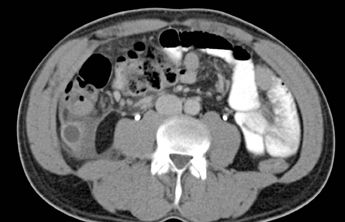Ruptured appendicitis



Ruptured appendicitis with an intraluminal foreign body (calcification around a metallic paperclip)
Findings
Contrast-enhanced CT of the pelvis with coronal reconstructions demonstrated a thickened and inflamed appendix in retrocecal position. A 3.2 cm appendicolith was present within the appendiceal lumen. Review of the coronal images in bone windows revealed a metallic paperclip in the center of appendicolith. Additionally, a small amount of free fluid was localized around the inflamed appendix, consistent with perforation. On questioning, patient did not recall foreign body ingestion.
Discussion
The first appendectomy was performed in 1736 at Westminster Hospital in London on an 11-year-old boy. At the time of surgery, a sewing pin was found to have perforated appendix.1
Foreign body appendicitis is uncommon but well described. It occurs in 0.0005% of cases of appendicitis.1–5 Various objects have been reported in the literature, including bird shot, air gun pellets, bullets, pins, needles, teeth, dental drill bits, toothpicks, bone fragments, fish-bone, fruit seeds and pits, chewing gum, gallstones, fishhooks, keys, coins, gastric tube and condom fragments, tongue studs, earrings, necklace, intrauterine contraceptive device.1–3 Once the foreign body is lodged in the appendix, peristaltic motion is insufficient to expel it back into the cecal lumen. It may perforate immediately or progress to obstruction depending on morphologic characteristics. Long, pointed, thin,stiff, sharp and/or metallic objects are more prone to cause perforation and are defined as risky. Blunt, smooth, round, soft foreign bodies such as seeds, hair, enteroliths carry less risk of causing perforation but are frequently responsible for total obstruction resulting in acute or chronic appendicitis or an appendiceal mucocele.3,5 Additional complications resulting from retention of foreign bodies in the appendix can include fistula formation, development of intraabdominal and liver abscesses, fecal peritonitis and clinically significant lead intoxication when large numbers of shotgun pellets or bullets are present.1–4 The latter is common in people consuming wild game.
Because foreign bodies in the appendix are rare, reported management varies. Known, asymptomatic foreign bodies that are associated with high risk of perforation may be retrieved via endoscope or removed via laparoscopy with appendectomy, cecotomy or ileotomy.1,3 Elective prophylactic removal of the appendix may be indicated even in patients with low risk foreign bodies. Surgical or endoscopic intervention should also be considered for retained lead objects to prevent chronic lead toxicity.2
This patient underwent laparoscopic appendectomy. Surgical pathology revealed a perforated gangrenous appendix with large,impacted, friable intraluminal appendicolith in the distal portion. The fecalith was sectioned and no metallic fragments were identified. The striking similarity of the internal structure of the appendicolith to a paperclip on CT gives rise to speculation that the metallic paperclip underwent longterm chemical corrosion. The patient did not recollect any history of foreign body ingestion and probably had the paperclip lodged in the appendix since early childhood.
Conclusion
Foreign bodies are rare causes of appendicitis. Rigid and/or sharp objects have the greatest potential for appendiceal perforation. Prophylactic appendectomy has been advocated after discovery of an appendiceal foreign body, particularly a sharp pointed object.
- Larsen AR, Blanton RH. Appendicitis due to bird shot ingestion: A case study. Am Surg. 2000;66:589-591.
- Mincheff TV. Bullet fragment within the appendix: A case report. JSC Med Assoc. 2004;100:270-273.
- Klinger PJ, Seeling MH, DeVault KR, et al. Ingested foreign bodies within the appendix: A 100-year review of the literature. Dig Dis. 1998;16: 308-314.
- Sukhotnik I, Klin B, Siplovich L. Foreign-body appendicitis. J Pediatr Surg. 1995;30:1515-1516.
- Shake JG, Kronz JD, Rodeberg DA, Colombani PM. Foreign bodies within the appendix: A case report and literature review. Contemp Surg, 2000; 56:10-14.
